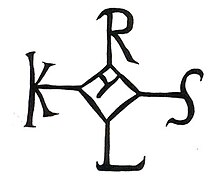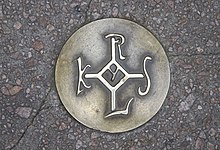Karolus monogram
The Karolus monogram (also Charles monogram ) was the official sign of Charlemagne , who, even unable to write, had a scribe dictate the monogram and gave the signum validity with a final line, the completion line .
The monogram consists of the letters KRLS connected by a cross, which are arranged around a rhombus with the completion line in the form of a y in the upper part. The diamond gives an O, while the upper half can be read as A and the lower half as U. In the correct order that results in CAROLUS.
Such monograms were already known in pre-Carolingian times, but there on coins, because the rulers of the Merovingians and earlier were able to write so that they could sign documents themselves. On the denarius from 793/794 the monogram was struck on the reverse of the coin.
140 nails with the Karolus monogram in their heads mark the 1.5 km long circular route "Kaiser Karl leads through Aachen ", which has been leading from the Elisenbrunnen to various sights in the old town since 2002.
Individual evidence
- ^ A b Johann Lechner: The monogram in the documents of Charlemagne In: New archive of the society for older German history, 1905
- ^ Clemens-August Heusch: The electronic signature . Tenea Verlag, 2004, ISBN 978-3-86504-097-8 , pp. 16 ( full text in Google Book Search).
- ^ Rainer Leng, Mathias Herweg: coin reform of Charlemagne. (No longer available online.) In: Institute for History, University of Würzburg. Archived from the original on December 3, 2016 ; accessed on November 29, 2016 .
- ↑ Emperor Karl leads through Aachen. In: Aachen city magazine Klenkes. April 4, 2014, accessed November 29, 2016 .

